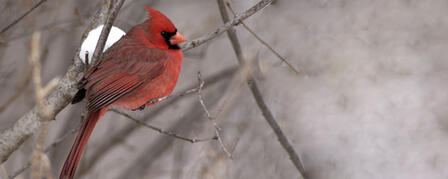WINTER BIRD FEEDER SURVEY HELPS TRACK SONG BIRD TRENDS

January 10, 2013
Popular annual bird watchers' event Jan. 17-20
PRATT — If you’re a winter bird watcher, you can enjoy the birds at your feeder and provide valuable population data by participating in the 2013 Kansas Winter Bird Feeder Survey. In its most recent report on wildlife-related recreation, the U.S. Fish and Wildlife Service reported that more than 750,000 Kansans enjoyed watching wildlife around their homes. For many, wildlife watching means birds at a feeder.
The Winter Bird Feeder Survey is a collaborative effort of the Kansas Department of Wildlife, Parks and Tourism (KDWPT), the Kansas Ornithological Society, and Kansas University Center for Science Education (KUSCIED). It is sponsored by KDWPT’s Chickadee Checkoff Program and helps biologists monitor songbird species.
This year, Kansas bird watchers are asked to choose two consecutive days during the time period of Jan. 17-20, and observe and record the number and species of birds visiting their backyard feeders. Watchers can report the results directly online at KUSCIED’s website, www.kuscied.org, or a survey form can be downloaded at the KDWPT website, www.ksoutdoors.com, and mailed to the address listed on the form. Information gleaned from this survey helps KDWPT track songbird population trends and types of feed that are most attractive to backyard birds. This long-term survey was expanded several years ago through the University of Kansas to include surveys around the nation. Information is reported by state, so Kansas results are separate.
During the two days viewers choose, they record the times of day observed, list the numbers of each species seen, and describe their feeders using the online or printed form. In spaces provided, they list the highest number of each species seen together at any one time. For example, if 10 juncos are seen at 9 a.m., 11 at noon, and seven at 4 p.m., the number recorded is 11.
Observers are asked to count only during the two consecutive days and record only birds seen at their feeders, under their feeders, or in cover around their feeders. Birds that fly past a house and do not use feeding areas should not be counted.
For more information, call KDWPT at 620-672-5911.
-30-









